
April 19, 2005. That’s when he sauntered into view with his natty black trench coat and Wolverine, Logan–sized frame. Ahmed Samsarra, White King—one of the only 3-drops in the history of Vs. System to rival Dr. Light, Master of Holograms for raw power (particularly now that the good Doctor has received some long overdue “surgery” from UDE’s own Zatanna to keep his powers under control).
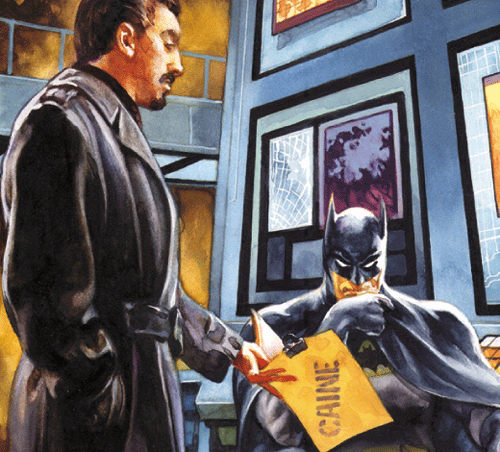
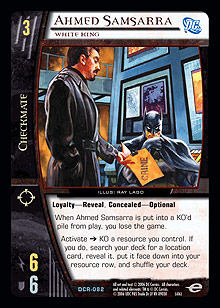 Of course, that raw power only means something in a context, but the Pro Circuit debut of the Silver Age format was a context that happily allowed him to flourish. It was the first step toward a major tournament format that took in a wide range of sets (and the diversity of teams that brings with it) but excluded the dominating Origins strategies and silver bullets that stomped around Golden Age tournaments like gorillas in the mist. No Dr. Doom, Diabolic Genius with all his brutal board control plot twists. No Roy Harper, Arsenal and his convoluted build phase machinegun rampages. No High Voltage throwing the fastest and most aggressive cards from every set in the game full in the face of off-balance opponents. This was a new, untested format with a dizzying array of possible strategies. Every Modern Age deck from past formats could be built; many Golden Age strategies could be tweaked, re-jigged, or simply ported over card-for-card into the new Age; and Infinite Crisis brought a lot of new material.
Of course, that raw power only means something in a context, but the Pro Circuit debut of the Silver Age format was a context that happily allowed him to flourish. It was the first step toward a major tournament format that took in a wide range of sets (and the diversity of teams that brings with it) but excluded the dominating Origins strategies and silver bullets that stomped around Golden Age tournaments like gorillas in the mist. No Dr. Doom, Diabolic Genius with all his brutal board control plot twists. No Roy Harper, Arsenal and his convoluted build phase machinegun rampages. No High Voltage throwing the fastest and most aggressive cards from every set in the game full in the face of off-balance opponents. This was a new, untested format with a dizzying array of possible strategies. Every Modern Age deck from past formats could be built; many Golden Age strategies could be tweaked, re-jigged, or simply ported over card-for-card into the new Age; and Infinite Crisis brought a lot of new material.
Dr. Light was the obvious benefactor of all this turmoil. A massively popular card in every format in which he’s been legal, his appeal is obvious. Even ignoring his potential in pure combo decks, if he stays alive for one recovery step, his 1 resource point investment (pay 3, then get an immediate free 2-drop) suddenly turns into a net profit of 1, 3, 5 resource points. So anything that wanted to compete with Dr. Light was going to have its work cut out for it. On the other side of the coin, there was Squadron Supreme, flying the flag for aggro munchkins everywhere with their lopsided stats and “look ma, no hands!” approach to life. Trying to compete with both the rush of Squadron and its relations and the tricky, fiddly plots that seem to follow Dr. Light around is quite a tightrope walk.
Enter the King.
First things first: staring you in the face are the raw stats. A 6 ATK / 6 DEF 3-drop with both range and concealed—optional is immense. Loyalty—reveal prevents him from being a trivial card to splash but doesn’t present any problems when working within his team. Then you hit the drawback. If he’s put into a KO’d pile from play, you lose the game. Okay, I think to myself, the ability better be pretty juicy to justify a drawback like that. And boy, was I not disappointed. Searching your deck for a location and putting it directly into the resource row for only the cost of an exhaust is an immensely powerful ability. The toolbox that Ahmed gives you access to stretches from team-ups to character tutors and takes in a satisfying range of combat tricks, utility cards, and focused hate. The trivial cost and repeatable nature of this tutoring simply make him all the more attractive.
Once you’ve recognized the double-edged power of a card like Ahmed, there are two questions to consider:
1) How can his drawback best be minimized? What is the most space-efficient way of doing it, what is the most reliable way of doing it, and what is the way of doing it that’s hardest to disrupt? Do you need multiple layers of protection, and if so, what do you need to do to fit them all together?
2) What deck and strategy can make the most use of his ability? What other cards give you the biggest payoff for being able to fetch locations at will?
The first question immediately threw up a few possibilities. Threat Neutralized was obvious but not a particularly powerful card in its own right, and also not searchable without running something like Scandal, Savage Spawn or Power and Wealth. Huntress, Reluctant Queen seemed like a likely inclusion; not only does it protect Ahmed from Quick Kill, No Mercy, and No Man Escapes the Manhunters, but it also protects all your characters from other disruption like X-Treme Maneuver and Magnetic Force (and even from ongoing removal like Mutant Massacre). But this didn’t feel like enough. So, for now I left the question of how to protect Ahmed on hold—I wanted to know what the payoff was going to be and if working on the payoff would point toward another solution to his unique drawback.
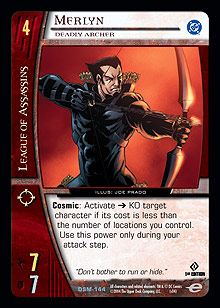 So, on to the second question. What to do with all those locations? I should probably point out that I’ve had a League of Assassins / Brotherhood deck in Golden Age since the release of Superman, Man of Steel (although it has been gathering a little dust in recent months), and as such, I’m familiar with the power of Merlyn, Deadly Archer. And the thought of running the White King with Merlyn had my eyes out on stalks. At a brainstorming session with Ian Vincent the day after the Sneak Preview tournament, I threw together a rough draft of what would turn into Deep Green, starting with four copies each of Ahmed and Merlyn. A check of the older available League of Assassins characters didn’t turn up that many (as one might expect of an Origins team), but Sensei, Martial Arts Master’s interaction with Merlyn was too good to pass up. We largely discounted the Batman starter deck characters; a copy of Hook, Hired Killer was the only serious consideration. Bronze Tiger, Benjamin Turner is a good man and also made the shortlist.
So, on to the second question. What to do with all those locations? I should probably point out that I’ve had a League of Assassins / Brotherhood deck in Golden Age since the release of Superman, Man of Steel (although it has been gathering a little dust in recent months), and as such, I’m familiar with the power of Merlyn, Deadly Archer. And the thought of running the White King with Merlyn had my eyes out on stalks. At a brainstorming session with Ian Vincent the day after the Sneak Preview tournament, I threw together a rough draft of what would turn into Deep Green, starting with four copies each of Ahmed and Merlyn. A check of the older available League of Assassins characters didn’t turn up that many (as one might expect of an Origins team), but Sensei, Martial Arts Master’s interaction with Merlyn was too good to pass up. We largely discounted the Batman starter deck characters; a copy of Hook, Hired Killer was the only serious consideration. Bronze Tiger, Benjamin Turner is a good man and also made the shortlist.
As for Checkmate characters, working up from 1-drops, Jacob Lee, Knight piqued my interest for having concealed and an alternate recruit cost that works a treat with a card I’d already marked out for use with Merlyn—Rook Control. The ability to drop Jacob into play for free on turn 4, switching him across with Merlyn, was an attractive one. Connie Webb, Knight was interesting but seemed unlikely to be necessary if we were running sufficient characters and appropriate tutors.
Looking at 2-drops, our options started to widen, and we started thinking about what we were likely to be playing against. We thought it likely that Squadron Supreme would be one of the most popular decks at the PC, and Ian pointed out that to be most comfortable against Squadron, we wanted two things to happen on turn 2: we wanted a 3 ATK 2-drop with which to stun Shape, Malleable Mutant or Melissa Gold ◊ Songbird, Sonic Carapace, and we wanted a Mikado and Mosha, Angels of Destruction in hand to stun Joystick, Janice Yanizesh or Ape X, Xina. As such, Bronze Tiger, Benjamin Turner just wasn’t going to cut it. Thankfully, Infinite Crisis gave us the perfect answer (in more ways than we realized) in the form of Talia, Beloved Betrayer. A 3 ATK / 3 DEF body, a useful vengeance ability, and not one but two useful affiliations? (And, for those of us who care about such things, fantastic art, to boot.) Where do I sign? We also decided that at least a single copy of Sarge Steel, Knight was essential, giving us a Checkmate 2-drop to fetch with Brother I Satellite if we miss Talia.
Moving up the curve, we toyed with a number of options for extra 3- and 4-drops. We wanted a few things: a non-King Checkmate 3-drop to fetch with Brother I Satellite if it wasn’t safe to make Ahmed; a Checkmate 4-drop to fetch in case we weren’t teamed-up with anything else; and some kind of plan to handle opposing Ahmeds, Dr. Lights, and other problem characters.
The backup 3-drop was, for a while, Christopher Smith ◊ Peacemaker, Obsessed Outlaw. We chose him for his ability to get stuns through to inconveniently hidden or protected Dr. Lights or an opposing Ahmed. He combined with a copy of Fatality, Flawless Victory at 4 to give us an alternate route for dealing with inconvenient smaller characters. But the more we tested, the more we found that the Christopher Smith into Fatality plan never quite seemed to gel, and Graziella Reza, Knight ended up coming in as a bigger character that could soak up some damage against the more aggressive decks.
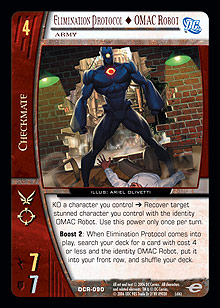 After some consideration, we finally settled on Elimination Protocol ◊ OMAC Robot, Army as our Checkmate 4-drop. While his stats are underwhelming, he’s visible (the 4-drops with backup abilities and concealed seemed likely to concede too much damage) and not a King. Harry Stein, King in Check seemed like a terrible idea, as we could get into serious trouble playing him after Ahmed and we couldn’t make use of his ability. Elimination Protocol also allows us to build up our hand size by discarding him to Brother I Satellite, Slaughter Swamp, or Enemy of My Enemy and then picking him back up with Brother Eye on turns where we don’t control the initiative.
After some consideration, we finally settled on Elimination Protocol ◊ OMAC Robot, Army as our Checkmate 4-drop. While his stats are underwhelming, he’s visible (the 4-drops with backup abilities and concealed seemed likely to concede too much damage) and not a King. Harry Stein, King in Check seemed like a terrible idea, as we could get into serious trouble playing him after Ahmed and we couldn’t make use of his ability. Elimination Protocol also allows us to build up our hand size by discarding him to Brother I Satellite, Slaughter Swamp, or Enemy of My Enemy and then picking him back up with Brother Eye on turns where we don’t control the initiative.
At 5, we had a few options. The first inclusion was Maxwell Lord, Black King. An immense body combined with a powerful payment power capable of doing everything from preventing reinforcement and team attacks to directly negating combat tricks made him a shoe-in. A non-King Checkmate character was, this time, easy to locate and much more attractive than Elimination Protocol—Annihilation Protocol ◊ OMAC Robot, Army is a character we were happy to make space for and that provided more fuel for Brother Eye. Talia, Daughter of Madness provides another Villains United drop with an ability that we could potentially make excellent use of with Sarge Steel in our deck, deploying him in the middle of combat via a Slaughter Swamp or search card discard to take the bullet for our 4- or 5-drop.
Turning to 6-drops, the first inclusion was, as suggested earlier, Sensei, Martial Arts Master. His synergy with Merlyn in a deck that is more capable than most of keeping Merlyn cosmically charged is undeniable, and it provides a devastating kick against any deck that plans to curve up. (G’Lock, for example, has issues with Sinestro, Green Lantern of Korugar being KO’d almost for free on turn 6.) Asmodeus, Duke of Hell, the deck’s Tim Willoughby Top Tech Tip™, provides another option against the slower decks, locking the game at six (or, if you prefer, seven) resources. Two copies of Huntress fill another dual role, providing a Checkmate 6-drop and, more importantly, providing another layer of protection for Ahmed via Huntress’s ability to negate plot twist effects (thus keeping your King and other characters safe from all manner of unpleasantness).
At 7, a single copy of Sasha Bordeaux, Autonomous Prototype went in. Although she would not end up being our preferred 7-drop, we felt it important to have Checkmate characters up the curve in case of draws where we felt it unsafe to drop Ahmed or couldn’t set up tutors for our off-team characters. A hunt for suitable, splashable 7-drops (particularly ones that are strong when we don’t control the initiative) turned up two main options: Aquaman, King of the Seven Seas and Spider-Man, The Amazing Spider-Man. Although Aquaman’s ability to bring back copies of Knightmare Scenario and locations to discard to Maxwell was nice, it quickly became apparent that with Slaughter Swamp and Sasha available, Spider-Man was by far the better choice; he could steal the initiative like some kind of garishly dressed cat burglar.
We decided not to run an 8-drop. We considered the only 8-drop likely to see play at the Pro Circuit to be Captain Marvel, Champion of Magic, and nothing we could play at that stage of the game would do anything to stop our opponent from busting a Cap at us.
Turning to plot twists, Enemy of My Enemy was an obvious inclusion to fetch the off-team late game characters. It also gave us better chances to hit Ahmed and Merlyn. That said, we felt (controversially, perhaps) that we only needed three copies of the card. I know that Ian plans to go into much more detail on the Enemy of My Enemy question in his report of the Pro Circuit itself, and I would recommend people keep an eye out for it.
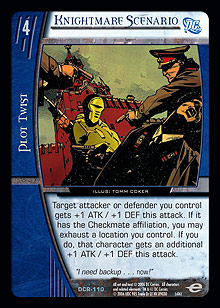 The next card to earn a slot was Knightmare Scenario. If there’s a single deck in Silver Age that would run Acrobatic Dodge if it could, it’s . . . well actually, it’s G’Lock. But Deep Green would be a close second. Knightmare Scenario may have a hefty threshold cost of 4, but it can have a dramatic effect on combat, especially on larger characters like Maxwell Lord. The additional cost of exhausting a location is easy to meet, usually with Brother I Satellite or (when we don’t control the initiative) Brother Eye.
The next card to earn a slot was Knightmare Scenario. If there’s a single deck in Silver Age that would run Acrobatic Dodge if it could, it’s . . . well actually, it’s G’Lock. But Deep Green would be a close second. Knightmare Scenario may have a hefty threshold cost of 4, but it can have a dramatic effect on combat, especially on larger characters like Maxwell Lord. The additional cost of exhausting a location is easy to meet, usually with Brother I Satellite or (when we don’t control the initiative) Brother Eye.
Certain locations were obvious inclusions. We wanted four copies of Brother I Satellite as our primary character tutor. We wanted a decent number of team-ups to increase the likelihood of naturally drawing into one for the splashed late game characters. UN Building was the first choice, as it teams-up Talia, Beloved Betrayer and Ahmed for Checkmate, League of Assassins, and Villains United in a single team-up. Checkmate Safe House was a shoe-in, providing both a team-up and a defensive trick in one. Some other locations were obvious inclusions—The Science Spire, Brother Eye, Slaughter Swamp, Rook Control, Coast City, and Sewer System all offered powerful effects either for managing the board, managing our hand, or preventing our Kings from being taken. Pit of Madness provided another layer to the arsenal of defensive tricks against the inevitable aggressive decks. In early builds of the deck, we had two copies of Pit of Madness, which let us use one Pit and then KO it to Ahmed to fetch the second, giving +4 or even +8 DEF on a single attack. Leslie Thompkins’s Clinic (which generally acts like a weaker Lazarus Pit, although the endurance gain is more significant than it appears at first glance) was an enabler for Pit of Madness and provided a little extra insurance for our Kings in the event that Maxwell and Ahmed were both stunned and we weren’t teamed-up for The Science Spire.
All of this left us with some empty slots. At this point, we had enough of the deck together to run some test games against Squadron, which we considered the benchmark reality check for the deck. If it couldn’t hang with Squadron, we either needed to make changes or go back to the drawing board, as the Squad was likely to be well represented at the PC. We quickly found that although the plan for the first couple of turns worked well, we needed something extra to push us over the edge in the mid-game to overcome Rocket Central and naturally high ATK values. The result was one of the most surprisingly effective cards in the deck—Knight Armor. Suddenly, the Squadron matchup did a complete 180. Ahmed was coming down in the visible area. Merlyn was KO’ing Lady Lark, Linda Lewis on turn 4, and then Ahmed was attacking Golden Archer, Wyatt McDonald without stunning back. Although Albert Gaines ◊ Nuke, Atomic Powerhouse was still sometimes getting through Slaughter Swamp on turn 5, one attack could generally be brick-walled on that turn. Going into turn 6, Merlyn often had his cosmic counter intact and ready to KO Nuke. Four copies of Knight Armor went in, taking us up to around sixty cards for further, more serious testing.
This seems like a good time for a list. This list is from a point relatively late in the testing cycle. Most of the card slots had settled down, and the discussions that followed were over relatively minor issues of numbers and extra characters we might need.
Characters
4 Mikado and Mosha, Angels of Destruction
4 Talia, Beloved Betrayer
2 Sarge Steel, Knight
4 Ahmed Samsarra, White King
1 Graziella Reza, Knight
4 Merlyn, Deadly Archer
1 Fatality, Flawless Victory
1 Elimination Protocol ◊ OMAC Robot, Army
2 Maxwell Lord, Black King
1 Talia, Daughter of Madness
1 Annihilation Protocol ◊ OMAC Robot, Army
2 Huntress, Reluctant Queen
1 Sensei, Martial Arts Master
1 Asmodeus, Duke of Hell
1 Sasha Bordeaux, Autonomous Prototype
1 Spider-Man, The Amazing Spider-Man
Plot Twists
3 Enemy of My Enemy
4 Knightmare Scenario
Locations
4 Brother I Satellite
3 Checkmate Safe House
2 Brother Eye
2 Pit of Madness
1 UN Building
1 The Science Spire
1 Slaughter Swamp
1 Sewer System
1 Rook Control
1 Coast City
1 Leslie Thompkins’s Clinic
Equipment
4 Knight Armor
Tomorrow: Part 2!